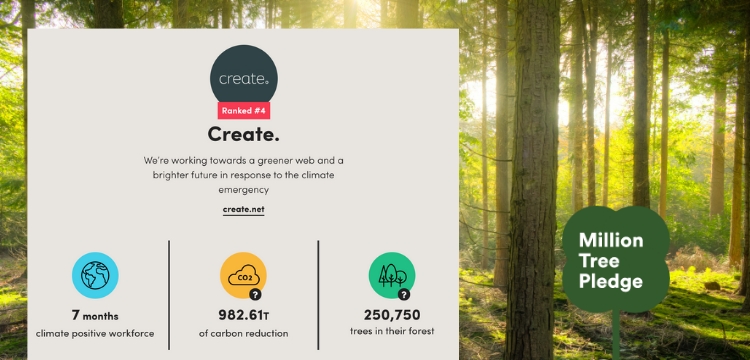Blog > 7 Ideas on Becoming a More Sustainable Business
Posted By Create

It’s no secret that we are in the midst of a climate crisis. No matter which way we turn, it seems that someone is there to tell us about all the damage being caused; the frustrating thing is, no one seems to be telling us what we can do to reverse it!
It falls to each of us to do our part. Many people link the idea of sustainability with recycling at home, reducing food waste, buying less single-use plastics and other household impacts.
One secret of the climate crisis is that it follows us into every aspect of our lives, including our work. In a professional setting, we can create far more damage to the planet than we realise.
It can often be hard to know where to begin when implementing changes in your workplace. The good news is that you don’t have to start with a 50-page action plan for your business. Change can start small with a few new habits and simple switches.
Here are some ideas to get you started:
Switch to Greener Energy

Switching to a greener energy source can sound tiresome, and comparing tariffs can be confusing. The truth is, it probably will take a bit of work, but it will be well worthwhile in your journey to becoming a sustainable business. If the energy you are sourcing is green, this can be a considerable step to eliminating your carbon footprint.
The good news is that there are increasingly more options to choose from as green energy becomes more prevalent. Some are greener than others, but these companies will be happy to work with you to select a tariff that works for you. What’s more is that the more sustainable energy suppliers are often smaller companies, meaning that you’re more likely to speak with a real person when you need to sort something out.
Why not take a look at some green comparisons on your energy >>
Alternatively, maybe you’re looking to take more control over your energy and source it sustainably for yourself? Many small business owners are looking to solar or wind energy as a means of powering their operations.
This option isn’t for everyone, and it does require a significant investment upfront. However, the cost savings over the long term can be substantial. Not only that but in some instances, they’ve generated enough power that they’ve been able to sell some of it back to suppliers, and it makes for a great conversation point to highlight to your customers.
It's fascinating to read about the different energy sources available and how you can do your bit by getting involved with the switch. Whether you want to have your own personal energy sources installed, such as solar panels or if you simply want to change your energy supplier, there's a wealth of information now available online.
Do More by Drawing Down Carbon

It is, of course, best for the environment if you work to eliminate as many carbon emissions your company is responsible for as possible. However, if you can go further to invest in projects that draw down carbon from our atmosphere, this can help you to reduce your carbon footprint and even potentially give back more than your take.
This could be through investing in initiatives such as tree planting, the building of wind farms, the funding of carbon sequestration technologies and more. These projects help to capture carbon from the atmosphere and sequester it so it isn’t eating into the ozone.
Getting involved in these projects has become a lot more straightforward in recent times. At Create, we’ve planted over 400,000 trees and invested in other carbon restorative projects through ecologi.com. Ecologi helps make these initiatives more accessible to smaller investors and they provide a helpful dashboard to monitor your impact.
In fact, with Ecologi, we've made it easier than ever to get started with a tree planting initiative through your website. By easily linking your two accounts, you can plant a tree for each shop order you receive >>
While this is a powerful way to work to eliminate your carbon footprint, it's also an inspiring talking point to discuss with your customers. These projects work as a great way to visualise how else you are helping to fight the climate emergency.
Find out more about becoming climate positive >>
Reduce, Reuse, Recycle

Recycling is something we should all be practising routinely as part of our daily lives. However, we can go a step further to reduce our waste and its demanding toll on the environment.
The concept of Reduce, Reuse, Recycle challenges us to reconsider our habits altogether. It is a prioritised list that encourages us to consider our environmental impact, even before the point of purchase:
-
Reduce - Is the purchase essential, or can it be avoided? By finding alternatives, you’re not only saving yourself money, but you’re also saving the energy and waste expenses of production and delivery. A couple of examples of this would be going paperless or removing single-use water cups in your office.
-
Reuse - What can be reused instead of recycled? Many of your old items you might just throw away can be repurposed or used by someone else. For example, you can reuse old packaging materials to send your own goods. For items you have no use for, consider offering them for free to local community projects or other businesses who may have a use for them.
-
Recycle - Repurposing your rubbish through recycling will still demand energy, but this is still a great way to keep your waste products out of landfill, where it could take up to 100 years to degrade!
How can this idea be applied to your working day? Are there certain products you can adapt to work without? Can you reuse any of what you’d typically throw away? Is everyone making their best effort to recycle correctly? Answering these questions can be an excellent way to start thinking about sustainability in the workplace.
Watch Your Energy Usage

Energy use affects us both at home and in the workplace, and many of the changes we can make go hand in hand for both. Most people know that turning off appliances when not in use is a great way to save energy, but there are hundreds of ways you can help reduce your carbon footprint by reducing your energy usage.
Here are some changes you could implement around your workplace to reduce your energy output:
-
Switch to LED or power-saving bulbs
-
Reduce your monitor brightness
-
Switch off appliances at the wall or invest in timed plug sockets
-
Invest in light sensors
-
Go paperless
-
Upgrade your appliances
There are plenty more ideas, and depending on how far you’re willing to go, you can make a significant impact on your carbon footprint. For example, you could invest in solar panels or wind turbines to generate your own clean energy or invest in insulation and double glazing to keep your office space warmer for longer. This isn’t to say the small changes won’t stack up. Research suggests that reducing your screen brightness from 100% to 70% can reduce the energy used by your monitor by up to 20%!
Consider Your Online Carbon Footprint

We use energy doing most things we do daily, which more often than not means we’re releasing carbon into the atmosphere without even realising. One of the biggest culprits of these surprising hidden carbon emissions is the internet, accounting for approximately 3.7% of global greenhouse emissions, which is similar to that of the airline industry.
As a business owner, this may at first appear to be quite daunting. It’s not like you can just stop sending emails or not have a website. Luckily there are things you can do:
-
Encourage your email recipients to only reply when necessary in your email signature
-
Unsubscribe to email newsletters you’re no longer interested in
-
Only add necessary attachments to your email
-
Delete your unneeded emails (if everyone around the world deleted ten emails, it would save 55.2 million kWh of energy)
-
Set your email client to only download images when you specifically tell it to
-
Use Ecosia as your default search engine (They’ll use the ad revenue from your searches to plant trees)
Some of these ideas are small steps you can take; other’s require more of a commitment. In taking these steps though, you can help tackle one of the significant threats to climate change.
Select Responsible Suppliers

Becoming more sustainable over the long term requires not only adapting your own business, it also requires looking at your suppliers and associates operations. Do they share the same goals and ambitions as you with regards to sustainability?
Your spending has the power to shape the future. By choosing sustainable suppliers, you are voting for them over their potentially less sustainable competitors and driving their business forward. This can lead to more of the change we’d all like to see in the world.
As a business owner, you can be a leader in the fight against climate change, and it’s essential to surround yourself with other leaders who feel the same way as you. Together, you’re better able to reinforce your message and create positive change. Here are some considerations when choosing suppliers:
-
Are they local? If you can find local suppliers or associates, you can reduce the impact of travel and support your community.
-
Do they have a sustainability policy on their website? This shows some level of commitment to being, or becoming, a greener business.
-
What actions are they taking? Anyone can promise to be more eco-friendly. What steps have they taken to prove they mean to fulfil their promises?
Increase Your Awareness

The very fact that you’ve made it to this article is an excellent start on your journey to create a more environmentally-friendly business. The first step towards tackling any problem is understanding how it is caused in the first place. Here are some more ways in which you can track your footprint and increase your understanding of the issues being faced:
-
Smart meters - Smart meters are the next generation way of measuring your use of electricity and gas. They allow you to see in real-time how much energy you are using and what this equates to financially. They're a fantastic way to encourage yourself and your team to be more energy-aware and to save some money along the way too.
-
Get certified as a sustainable green business - This a brilliant way to get help setting targets and for making plans for a more sustainable business. With so many people actively searching for green companies to use and support, it can also be a great selling point for your services or products.
-
Join the Discussion - Being more sustainable can be a complicated topic at times. Especially the deeper you delve into the subject. There are many online communities you can participate in to discover new perspectives and ideas that you can build into your own sustainability strategy.
-
Set targets for reducing your energy impact - When you have a way to track your energy output, setting targets is a fantastic way to keep motivated and on track. Additionally, it’s a great way to inform your customers and clients of the progress you've achieved in helping combat the climate crisis.
Wrapping Up
Here are seven ways that your business can become more sustainable:
- Switch to Greener Energy - Take a look at some sustainable energy comparisons and see if there’s an alternative that could work for you. You could even go as far as sourcing your own energy with solar and wind power.
- Do More by Drawing Down Carbon - By actively pursuing projects that draw down carbon, you can go the extra mile in eliminating your carbon footprint. You could even end up giving more back to the environment than you take!
- Reduce, Reuse, Recycle - Don’t be so quick to buy lots and recycle straightaway. Assess your requirements and if you can put any old materials to work before recycling.
- Watch Your Energy Usage - Small changes around your workspace or office can soon add up to a significant impact on your carbon footprint.
- Consider Your Online Carbon Footprint - The Internet is surprisingly a massive contributor to carbon emissions. Cut down on your emails where you can and make sure your website runs sustainably.
- Select Responsible Suppliers - Your impact extends beyond how you choose to operate within your business. Make sure you’re teaming up with other conscious business leaders.
- Increase Your Awareness - Stay up to speed with the current issues and continue learning what you can about sustainability. There are plenty of online discussions you can join, and who would value hearing about your own experience!
Any step that you choose to start with will be a force for good. Little changes build up to make massive differences over time. The key is just to get started, no matter how big or small the action you take feels.
What actions have you been taking in your business? Do you have any more ideas or initiatives you’d like to share? Let us know in the comments below about how your business is making a difference.

